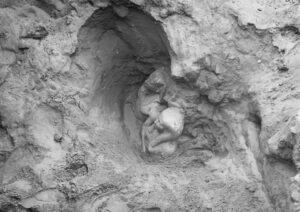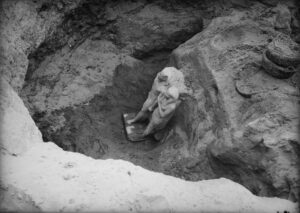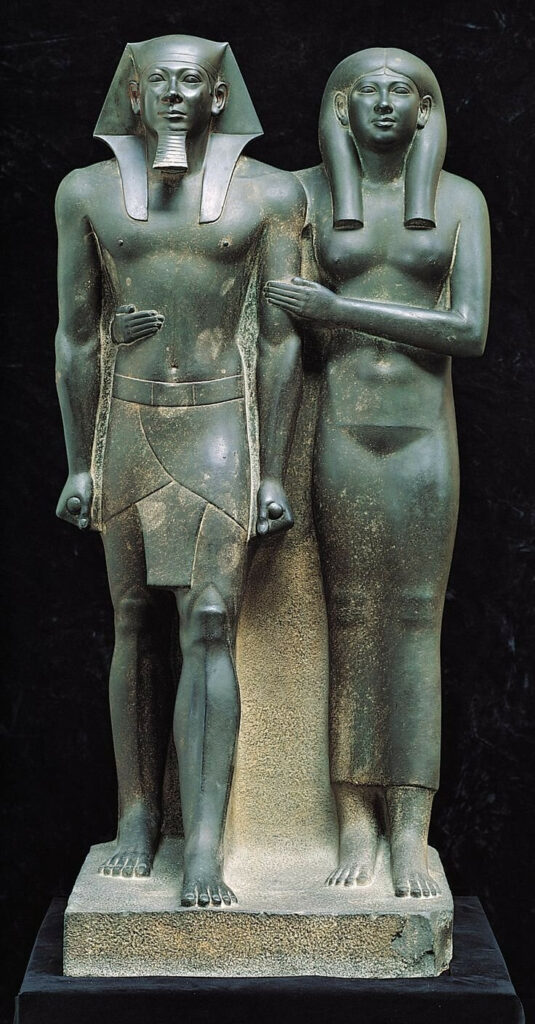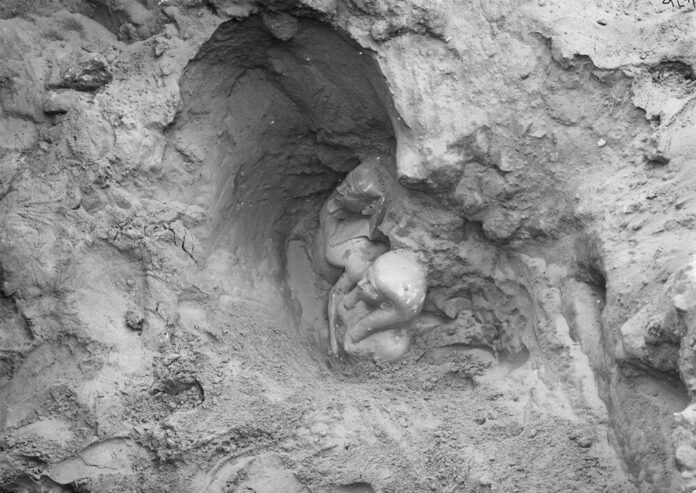The Excavation
The Valley Temple of Menkaure
On January 10, 1910, George Reisner and his team from the Harvard University-Museum of Fine Arts Boston Expedition made an astonishing discovery in the Valley Temple connected to the Pyramid of Menkaure at Giza. While exploring the southwest corner of the structure, they uncovered a magnificent cache of statuary carved from a smooth-grained dark stone called greywacke or schist.

The Triads and Hathor’s Prominence
Among the finds were several triad statues depicting the king, the goddess Hathor, and the personification of a nome (a geographic region). Hathor, worshipped alongside the sun god Re and the god Horus, played a significant role in the pyramid temple complexes. Her prominence in the triads, even taking the central position in one sculpture, highlights her singular importance to kingship.

The Dyad Statue of Menkaure and His Queen
A Breathtaking Sculpture
The most extraordinary discovery was the nearly life-size dyad statue of Pharaoh Menkaure and a queen, capturing their serene beauty, raw royal power, and artistic virtuosity. The two figures stand side by side, Menkaure’s head turned slightly, as if emerging from an architectural niche.

Depictions of Eternal Youth and Ideal Beauty
Menkaure is portrayed as a broad-shouldered, youthful king, clad in a traditional pleated kilt and adorned with the iconic nemes headdress and artificial beard. His clenched fists hold ritual cloth rolls, and his features are remarkably individualized. The queen, sensuously modeled with a beautifully proportioned body, articulates ideal mature feminine beauty, her features also displaying a sense of individuality.
An Unusual Depiction
Unusually, the queen strides forward with her left foot, a pose typically reserved for males in Egyptian sculpture. Additionally, the king lacks the protective cobra (uraeus) on his brow, suggesting that the nemes and the queen’s wig were originally covered in precious metal.
A Rebirth for the King

While the sculpture was never finished and lacks a final polish and inscription, it was erected in the temple and brightly painted, possibly intended to reveal the immortal, black-fleshed “Osiris” Menkaure over time. The function of the dyad was to ensure the king’s rebirth in the Afterlife, and the prominence of the queen has led to speculation that she may have been Menkaure’s queen-mother rather than his wife.
The Eternal Monuments
Pyramids and Their Complexes
The pyramids of Giza were not stand-alone structures but part of much larger complexes that included temples, causeways, subsidiary pyramids, and valley temples. These valley temples were active places of worship long after the king’s death, where images of the ruler served as a focus for worship and the perpetuation of their cult.
Uncovering History
Reisner’s team had already explored the elite cemetery west of the Great Pyramid of Khufu before turning their attention to the barely-touched Valley Temple of Menkaure’s complex. Their excavations revealed a wealth of information about the rituals, beliefs, and artistic achievements of ancient Egyptian civilization.
Preserving the Past
The discovery of the dyad statue and other artifacts from Menkaure’s Valley Temple provides a glimpse into the lives and beliefs of the ancient Egyptian rulers. These remarkable finds, now preserved in museums, continue to captivate and inspire people worldwide, serving as eternal monuments to the enduring legacy of this fascinating civilization.
The Lasting Legacy
A Timeless Artistic Achievement
The discovery of Menkaure’s dyad statue and the other artifacts from the Valley Temple complex at Giza has shed light on the artistic mastery of ancient Egyptian sculptors. The exquisite craftsmanship, attention to detail, and ability to capture both idealized and individualized features in these sculptures have left a lasting impression on the art world.
Insights into Ancient Beliefs
Beyond their artistic value, these artifacts offer invaluable insights into the religious beliefs and funerary practices of the ancient Egyptians. The prominence of the goddess Hathor and the symbolic representations of geographic regions in the triad statues provide a glimpse into the complex belief systems and the importance of regional identities in that era.
A Window into the Past
The incomplete state of the dyad statue, with its traces of paint and unfinished areas, serves as a reminder of the ongoing nature of archaeological discoveries. Each artifact, no matter how fragmentary, has the potential to reveal new information about the lives, customs, and traditions of the people who created them.

Inspiring Future Generations
The remarkable finds from Menkaure’s Valley Temple continue to captivate visitors and scholars alike, inspiring a deep appreciation for the rich cultural heritage of ancient Egypt. These discoveries have paved the way for further archaeological explorations and have motivated generations of researchers to unravel the mysteries of this extraordinary civilization.

